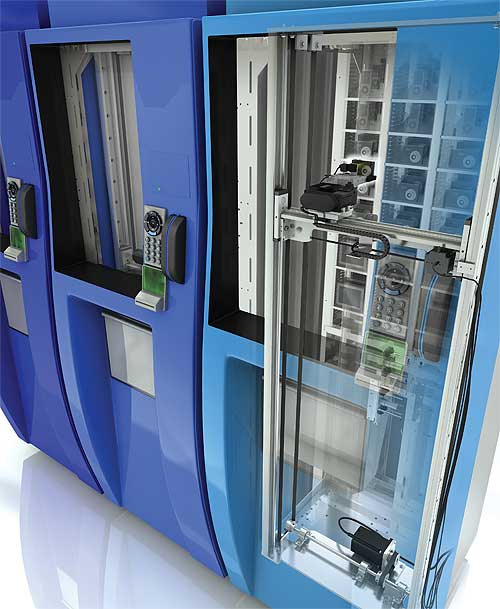By Mark Huebner, Production Manager, PBC Linear, Rockford, IL
Understanding the complexities of kiosk design can help you address the common pitfalls in selecting the best mechanical components for the job.
Automated retail and self-service kiosks are springing up everywhere, dispensing a wide variety of products ranging from inexpensive snack foods to costly electronic equipment such as iPads. These newer dispensing or vending machines require reliable mechanical components and sophisticated electronic control.
Kiosk design can be a complex process often involving multiple factors. However, following these six simple design tips will help ensure that you properly select the right mechanical components, develop reliable and repeatable assembly processes, and ultimately extend the useful life of the system.

1) Know the product
This is where it all begins; the product specifics such as shape, size, quantity, packaging, weight, and cost. All of these come into play when designing storage and retrieval systems for products in a kiosk.
Typically, higher value products like consumer electronics or sensitive bio-samples, require a larger investment in mechatronics to ensure reliable, complex handling and repeatable delivery. Lower cost items like DVDs are often stored in same-size packaging and are easily inventoried on racks, while higher value items may be colorfully wrapped and on display to attract potential customers.
Packages with odd shapes and sizes also warrant a more sophisticated mechanical delivery system to handle higher loads or to be more precise. For instance, if a kiosk carries items that vary in size, such as one with both electronics and accessories, the delivery system must be programmed to recognize how each item is different. In this case, sensors and vision systems can be used to read bar codes in order to ensure the retrieval system recognizes the correct selected item.
2) Decide which mechanical configuration is best
Generally, the mechanical delivery systems are specially designed Cartesian robots whose parameters are defined by the specific task they need to fulfill. Common examples of delivery system formats are carousel, H-type and I-type, as described below.

A carousel-style kiosk displays products on racks on a circular rotating table.
The carousel configuration features products on racks on a circular rotating table. The Y-axis moves components that pick an item and deliver it to the user. The axis is driven along a single rail or guide fixed to the base on one side of the enclosure. Typical uses for carousel style vending machines are in DVD vending, well plate storage, and similar applications.
Next are H-type configurations. As in carousel configurations, the product is stored on shelves in an enclosure. The vertical Y-axis guide rails support and provide movement for a single horizontal axis rail that moves along the X-axis. The slide components supported on the horizontal X-axis provide the in and out movement for the Z-axis, and support the picking mechanism. Uses can be the same as those in carousel setups but can also include media storage as well as pill dispensing or other general retail items.

An H-type configuration sports vertical axis guide rails and a horizontal axis rail with a picking mechanism.
Lastly, in the I-type configuration, the X-axis is guided by two rails that support a single vertical Y-axis rail. This Y-axis rail supports the slide components that provide the in and out Z-axis movement that deliver the product to the user. I-type configurations can be used with a wide number of versatile item sizes and extended length operations.

I-type kiosks feature two horizontal support rails with a vertical moving rail.
3) Select the linear guide component
When selecting a linear motion technology, many factors come into play such as travel speed, load, environment and cost to name a few. Once the mechanical configuration is selected and the factors involved with locating the product are understood, choosing the correct linear bearing and drive system is critical in order to reach the expected life cycle target—as well as to perform the retrieval and dispensing operations reliably and consistently.
Roller bearing products do well in these types of applications due to their low cost, high transfer speeds and moment load capability. They also provide consistent, repeatable travel over extended lengths. For example, roller bearings excel when installed as vertical Y-axis guide rails for H-type configurations, which require high repeatability and accuracy. Roller bearing linear guides provide smooth, fast and precise travel over extended lengths. However, cam roller systems can require periodic lubrication and maintenance to ensure long life.
Plain bearings thrive in the kiosk space due their simple design and low-maintenance operation. They do not contain rolling elements and are typically one-piece components. This eliminates catastrophic failure associated with stalled ball bearings. Also, plain bearings self-lubricate, meaning they do not require additional grease or oil to be added periodically. In most cases, plain bearings function well for Z-axis gripping systems, providing reliable short stroke product retrieval. However, one thing to keep in mind look out for when using plain bearings is the moment load.
Recirculating ball bearings operate at low friction and as provide accurate and precise travel. However, they are more costly than the alternatives and require moderate to complex alignment procedures.
Applying each of these bearing technologies depends upon the configuration of the delivery system: H-Type, I-Type and carousel. When selecting a technology, keep the above performance factors in mind for sustained operation in the field.
4) Design for assembly
One challenging factor of kiosk design is assembly. Made up of thousands of different interconnecting parts, including mounting components, fasteners, mechanical components, motion controls, sensors, storage compartments and more, a kiosk assembly is nothing short of a complex puzzle in a compact space. So when it comes to setup and installation, a lot can go wrong.
Design for assembly (DFA) principles can solve this issue. They can reduce installation steps and simplify set-up, thereby reducing total installed cost and saving time. One approach is to integrate linear guide technology into the structural framing or overall design. For example, designing a linear guide that is machined directly into the framework reduces the number of mounting components and fasteners as well as the chances for misalignment and preventative maintenance issues.
Another key concern is alignment. The most precise mechatronics and linear guide products cannot help a misaligned system. Misalignment puts considerable stress on a delivery system, and can lead to stalling or even complete machine failure. Therefore, designing a system that streamlines alignment vastly improves the potential for success in automated kiosks. Assembly procedures for the structural framing that ensure the angularity and parallelism should be a prime consideration. Combining linear guides with structural framing can simplify this process for installers by having them work with fewer components.
Again, the use of sensors and vision systems can offer advantages in the assembly and framing process. Using vision sensors to locate the edge of the product to be picked from inventory allows the designer and builder to use a frame or shelving structure that is less precise and less costly. This, in turn, can free up time and money to focus on the alignment, accuracy and repeatability of the linear motion system.
5) Choose rack, screw or belt drive
The linear guide system can be driven by a number of options. Often these are decided based upon the needs of the application. However, it is important to consider the benefits of each type of drive to decide where it can optimally be used within the kiosk:
Lead screw: a metal shaft that is threaded and uses a polymer nut to drive mechanical components. Lead screws provide very accurate positioning for short-length adjustment tasks. The maximum length a lead screw can tolerate varies and is based upon two main factors; critical speed and column strength. As a general rule, the larger the screw diameter, the longer it can be. For kiosk design, lead screws are good for Z-axis gripping and pick-and-place operations. However, be sure to use caution when using lead screws on high loads or extended lengths, as both can result in the screw whipping.
Rack: A pinion gear driven by a motor that guides the rack. Rack-and-pinion systems are low cost and efficient. Often times they are used in either length constrained applications or extended length applications. For short length tasks, rack-and-pinion technology conserves space by eliminating end blocks. In extended length applications, rack-and-pinion systems excel by providing more stability and rigidity than a belt-driven system. One downside is that the motor must travel with the rack and this setup requires additional cable carriers.
Belt: These consist of a drive pulley, belt, carriage and idler pulley. Belt drive systems travel at high speeds (up to 10 m/sec) and ensure high acceleration with sustained velocity. In kiosk design, they are ideal for transferring or cycling at medium to extended lengths. Equipped with steel reinforced timing belts, belt driven systems offer repeatable travel in lengths up to 20 ft. However, over time, even a reinforced belt will stretch and cause performance issues.
6) Plan for proper life expectancy
Proper evaluation and testing will reveal which mechanical components will require preventative maintenance, when it should be scheduled, and what item will fail first. Establishing a defined life expectancy timeline for a new kiosk is a crucial factor in kiosk design.
The purpose of automated retail is self-service. For this to be successful, the proper steps must be taken to ensure mechanical reliability for the life of the system. Each individual kiosk will not have an on-site engineer to fix performance issues. The system must stand alone; therefore, it must be designed to last for the extent of the life cycle.
For starters, use low-maintenance parts. When possible, installing products with lubrication wipers or self-lubricating bearings enhances the reliability, performance and life expectancy of your system by not requiring periodic lubrication.
Also, consider cable management, which is usually a key determining factor for life expectancy. Too often, designers leave the cable mounting and routing until the end and treat it as an afterthought in the design process. Yet for high cycle systems, poor cable management is the leading cause of early failure. Some common causes of cable failure include bad connectors, too many wires and cables, poor cable carrier selection, and improper strain relief on cables.
These common mistakes cause early cable carrier breakage, fraying of the wires and eventually machine failure. To avoid this problem, design with cable management in mind from the beginning and use high flex cables for high cycle kiosk tasks.
These are just a few of the most important of the many different variables that constitute the mechanical side of a defined kiosk system. There are many other factors to consider in kiosk design and deployment, such as environment, presentation and software.
As automation technology improves, self-service kiosks will continue to be a growing solution applied to a multitude of tasks in the lab automation, media storage and retrieval, retail, and entertainment industries.
PBC Linear
www.pbclinear.com
::Design World::
Filed Under: Factory automation, LINEAR MOTION, Motion control • motor controls






Tell Us What You Think!